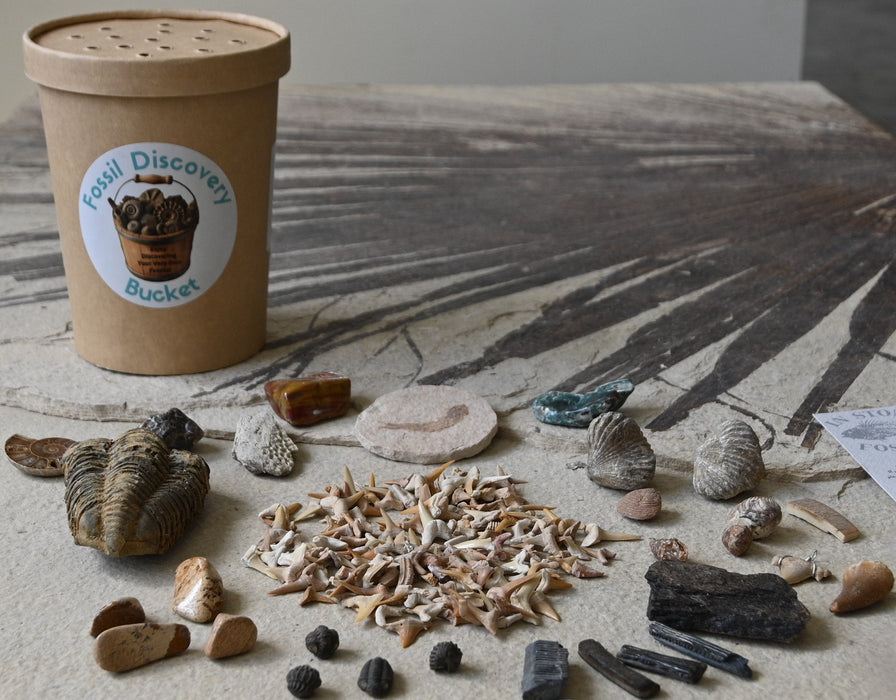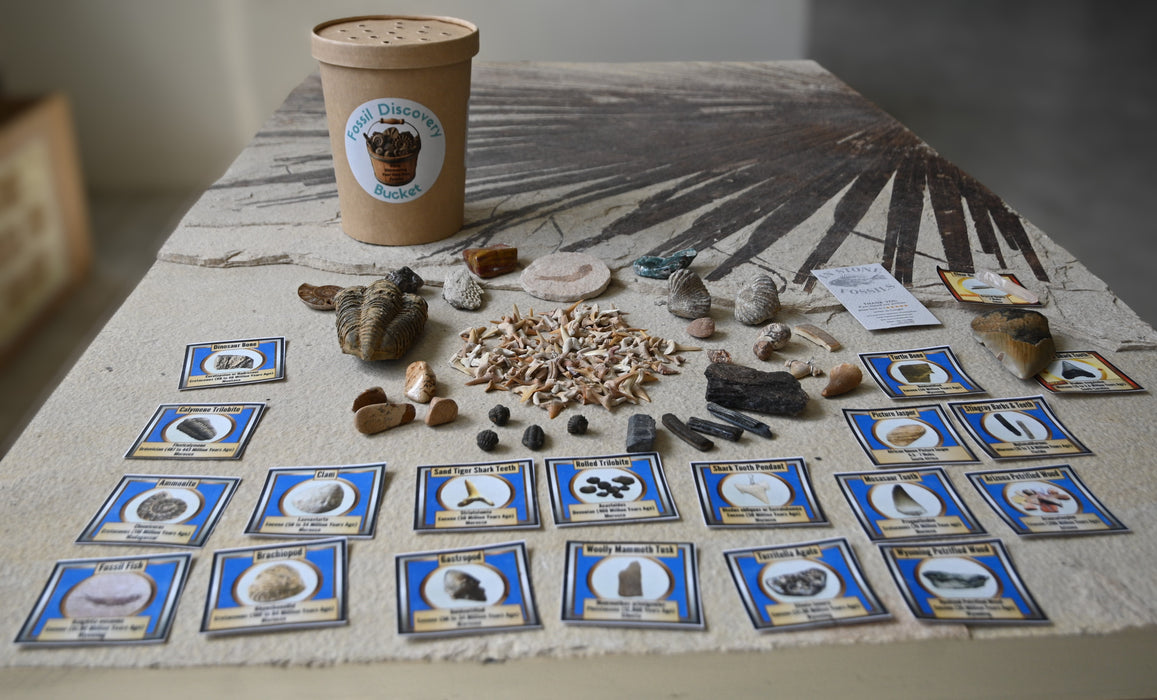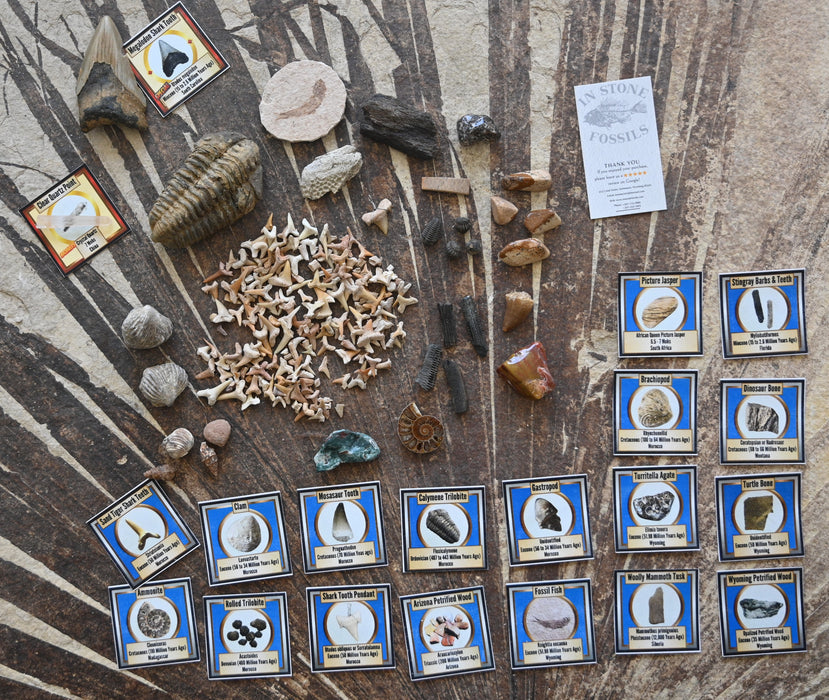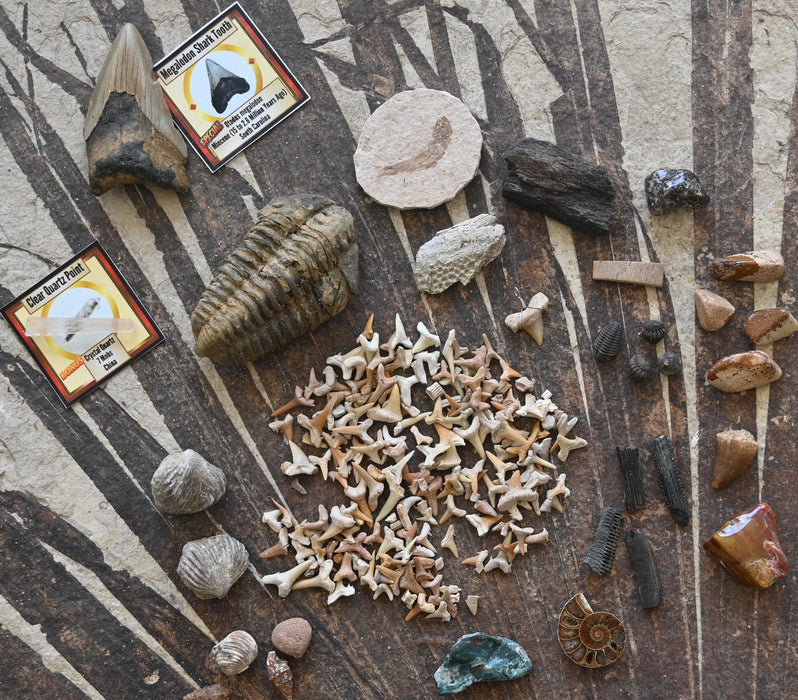
Fossil Discovery Bucket
Dig into history with our Fossil Discovery Bucket, a hands-on experience for fossil enthusiasts of all ages! Each 32 oz. bucket is packed with authentic, real fossils waiting to be uncovered. From ancient shark teeth and ammonites to fossilized shells and trilobites, every scoop holds a piece of prehistoric life.
🔎 What’s Inside?
✔ A variety of real fossils from different time periods
✔ Identification cards to help you learn about your finds
✔ Tools to assist in your fossil-hunting adventure
Perfect for kids, collectors, and anyone who loves the thrill of discovery! Whether you're starting a new hobby or adding to your collection, the Fossil Discovery Bucket guarantees a fun and educational experience.
You will receive (All hand selected items. Items may vary from photos):
- 2 oz. of Sand Tiger Shark teeth
- Two Brachiopods
- Two Bivalve Clam Shells
- Two Fossil Gastropod Shells
- One piece of Arizona Petrified Wood
- Two pieces of Stingray Barbs
- Two pieces of Stingray Teeth (Crushing Plates)
- One Mosasaur tooth
- One Ammonite half
- One piece of Bridger Formation Turtle Bone
- One piece of Dinosaur Bone
- One Green River Formation Knightia eocaena fish fossil
- One piece of Wyoming Petrified Wood
- Four pieces of tumbled Picture Jasper
- One piece of Woolly Mammoth Tusk
- One shark tooth pendant
- One piece of tumbled Turritella Agate
- Four Acastoides Trilobites
- One Calymene Trilobite (mud trilobite)
*Bonus: One in every 40 buckets will include an authentic Megalodon Shark tooth, valued between $30-$40.
Sand Tiger Shark Teeth
Species: Striatolamia sp. • Geological Age: Eocene (50 million years ago) • Location: Khouribga Province, Morocco
Striatolamia is an extinct genus of sharks belonging to the family Odontaspididae. These extinct sharks lived from the Early Paleocene to Late Miocene (61.7 to 10.3 Ma). The Latin genus name Striatolamia refers to the striations on the surface of the teeth. Striatolamia species could reach a length of about 3.5 meters.
Brachiopod
Species: Rhynchonellid sp. • Geological Age: Cretaceous (100 to 64 million years ago) • Location: Boujdour, Morocco
Bivalve Clam
Species: Laevastarte sp. • Geological Age: Eocene (56 to 33.9 million years ago) • Location: The Ouled Abdoun Basin, also known as Khouribga Basin, Khouribga, Morocco
Gastropod
Species: Unidentified • Geological Age: Eocene (56 to 33.9 million years ago) • Location: Morocco
Arizona Petrified Wood
Species: Araucarioxylon • Geological Age: Triassic (200 million years ago) • Location: Arizona
The extinct conifer Araucarioxylon arizonicum happens to be the state fossil of Arizona. The petrified wood of this tree is frequently referred to as "Rainbow wood" because of the large variety of colors some specimens exhibit. The reds and oranges come from hematite inclusions and the yellows come from limonite. The purples come from very tiny spherules of hematite, contrary to previous beliefs that it was caused by manganese.
Stingray Barbs and Crushing Plates
Species: Myliobatiformes • Geological Age: Miocene (15 to 2.6 million years ago) • Location: Florida
Myliobatiformes are one of the four orders of batoids, cartilaginous fish related to sharks. This order includes modern stingrays, eagle rays, manta rays, and their extinct relatives. Like other batoids, Myliobatiformes have a flattened body shape with enlarged pectoral fins, forming a broad disc. Rather than true bone, their skeletons are composed of cartilage, which is rarely fossilized except for mineralized portions like teeth, dermal denticles, and occasionally vertebrae. Many species developed a long, slender tail with one or more venomous barbed spines used for defense. Additionally, many developed flat dentition suited for crushing hard-shelled prey like mollusks and crustaceans.
Mosasaur Tooth
Species: Prognathodon • Geological Age: Cretaceous (70 million years ago) • Location: Morocco
About 80 million years ago, large marine reptiles called Mosasaurs dominated the oceans. These air-breathing creatures were powerful swimmers, perfectly adapted to the warm, shallow inland seas of the Late Cretaceous period. Mosasaurs had huge, double-hinged jaws that enabled them to swallow their prey almost whole, in a snake-like fashion. Mosasaurs had a body shape like that of modern-day monitor lizards but were more streamlined for swimming. Their limb bones were shortened, and their paddles were created by webbing between their elongated finger and toe bones. Their tails were broad, providing them with the necessary propulsion for movement. Despite their dominance, Mosasaurs became extinct around 66 million years ago, at the end of the Cretaceous period.
Ammonite
Species: Cleoniceras • Geological Age: Cretaceous - Albian Stage (110 million years ago) • Location: Ambatolafia, Mahajanga Province, Madagascar
Ammonoids are a group of extinct marine mollusk animals in the subclass Ammonoidea of the class Cephalopoda. These mollusks, commonly referred to as ammonites, are more closely related to living coleoids (i.e., octopuses, squid, and cuttlefish) than they are to shelled nautiloids such as the living Nautilus species. The earliest ammonites appeared during the Devonian, and the last species vanished in the Cretaceous–Paleogene extinction event.
Turtle Bone
Species: Unidentified • Geological Age: Eocene (50.3 to 46.2 million years ago) • Location: Bridger Formation, Wyoming
Dinosaur Bone
Species: Ceratopsian or Hadrosaur • Geological Age: Cretaceous (68 to 66 million years ago) • Location: Hell Creek Formation, Montana
The Hell Creek Formation was home to many diverse dinosaurs, including two major herbivore groups - ceratopsians and hadrosaurs. The most famous ceratopsian of Hell Creek is Triceratops. This large, quadrupedal dinosaur had a massive frill, three facial horns, and a robust beak for cropping tough vegetation. The most prominent hadrosaur of Hell Creek is Edmontosaurus, a large, "duck-billed dinosaur" with a long, low skull and a broad, tooth-packed jaw for grinding plant material. It was a facultative biped, meaning it could walk on both two and four legs. Ceratopsians and hadrosaurs both may have lived in herds or groups, with ceratopsians living in smaller herds and hadrosaurs in larger ones.
Fossil Fish
Species: Knightia eocaena • Geological Age: Eocene (51.98 million years ago) • Location: Green River Formation, Wyoming
Knightia eocaena fossil from our private quarry. Knightia is an extinct genus of clupeid bony fish that lived in the freshwater lakes and rivers of North America and Asia during the Eocene. It is the state fossil of Wyoming, and the most commonly excavated fossil fish in the world. Knightia belongs to the same taxonomic family as herring and sardines, and resembled the former closely enough that both Knightia alta and Knightia eocaena were originally described as species of true herring in the genus Clupea. As with modern-day clupeids, Knightia likely fed on algae and diatoms, as well as insects and occasionally smaller fish. A small schooling fish, Knightia made an abundant food source for larger Eocene predators. The Green River Formation has yielded many fossils of larger fish species preying on Knightia.
Wyoming Petrified Wood
Species: Unidentified • Geological Age: Eocene (35 million years ago) • Location: Wyoming
Petrified Wood formed when the original trees and branches were rapidly buried under sediment and were initially preserved due to a lack of oxygen some 50 million years ago. Petrifaction occurs when water that contains inorganic minerals, such as calcium carbonate or silica, passes slowly through the organic wood. As the original wood’s lignin and cellulose decay away, its original cellular structure is duplicated and replaced by these inorganic minerals. Elements such as manganese, iron and copper in the water and sediment during the petrification process give petrified wood a variety of color ranges.
Picture Jasper is a variety of jasper that is characterized by patterning reminiscent of a scenic painting. Traditionally, this jasper has inclusions that produce a layered pattern that creates the illusion of a landscape. The landscapes are a result of deposition banding during formation. These layers are influenced by water flow and wind, in addition to coloring and dendritic patterning dictated by the composition of the inclusions. Picture jasper is a favorite of lapidarists because the material is easily cut, polished, shaped and is exciting throughout, meaning there is little waste.
Woolly Mammoth Tusk
Species: Mammuthus primigenius • Geological Age: Late Pleistocene (12,000 years ago) Ice Age • Location: Southwestern Siberia, Russia
The Woolly Mammoth is the iconic Pleistocene animal. They had long hair, tusks that extended up to 9 feet, and stood about 12 feet tall. They ranged across the northern hemisphere and were one of the most abundant Pleistocene creatures.
Shark Tooth Pendant
Species: Otodus obliquus or Serratolamna • Geological Age: Eocene (50 million years ago) • Location: Morocco
Otodus obliquus was a large mackerel shark that is an ancestor of the Megalodon. While not nearly as large as Megalodon, Otodus obliquus still reached about 9 meters (26-30 feet) in length. Serratolamna is another genus of mackerel shark that was much smaller than Otodus obliquus. Based on the size of its teeth, it appears Serratolamna grew no larger than 1.5 meters in length. Both sharks lived during the Eocene and their fossils are found in similar phosphate deposits.
Turritella Agate
Species: Elimia tenera • Geological Age: Eocene (51.98 million years ago) • Location: Wyoming
These stones are actually composed of agatized gastropod (snail) fossils from Wyoming. These fossils are Eocene in age or approximately 51.98 million years old. Technically, Turritella refers to the saltwater variety of snail. Elimia tenera is the proper name for this freshwater snail, but the name Turritella just stuck.
Rolled Trilobite
Species: Acastoides sp. • Geological Age: Devonian (400 million years ago) • Location: Morocco
These are tiny Acastoides trilobites from Morocco. Trilobites instinctively enrolled themselves in a defensive posture, resulting in them frequently being found preserved in this position. Trilobites, exclusively marine animals, first appeared at the beginning of the Cambrian Period, about 542 million years ago, when they dominated the seas. Although they became less abundant in succeeding geologic periods, a few forms persisted into the Permian Period, which ended about 251 million years ago.
Calymene Trilobite
Species: Flexicalymene sp. • Geological Age: Ordovician (487 to 443 million years ago) • Location: Anti-Atlas Region, Morocco
Flexicalymene trilobites are preserved as internal molds, essentially formed a natural three-dimensional fossil. Trilobites are any member of a group of extinct fossil arthropods easily recognized by their distinctive three-lobed, three-segmented form. Exclusively marine animals, trilobites first appeared at the beginning of the Cambrian Period, about 542 million years ago, when they dominated the seas. Although they became less abundant in succeeding geologic periods, a few forms persisted into the Permian Period, which ended about 251 million years ago.
WARNING: CHOKING HAZARD. SMALL PARTS.
CAUTION: SHARP OBJECTS INSIDE.
ADULT SUPERVISION IS RECOMMENDED.
NOT FOR CHILDREN UNDER 3 YEARS OLD.



